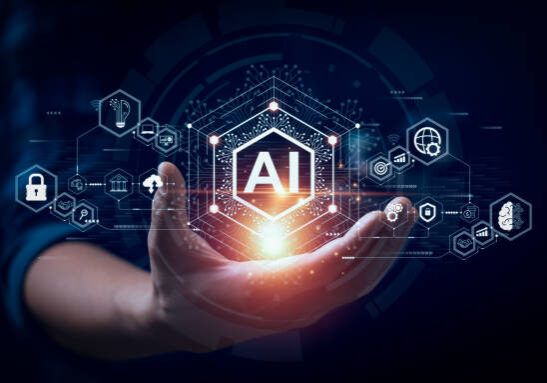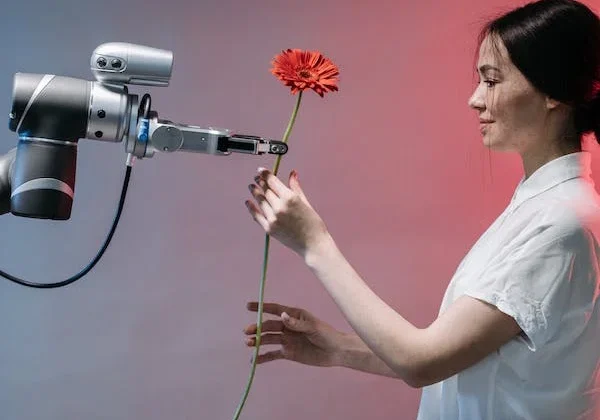AI Business & Tech Integration Available Here Now
Best AI Tools for Startups & Small Businesses , We Are Here to Assist

WHAT SHOULD YOU LOOK FOR IN AI TOOLS FOR SMALL BUSINESS OR STARTUPS?
Believe it or not, the term “artificial intelligence” (AI) dates back to 1956 when John McCarthy, an American computer scientist, coined the term during the first-ever AI conference.
Fast forward to 2023, and we’re in an exciting new era where AI, fueled by powerful machine learning algorithms, is on everyone’s minds. AI has gone from being a tech buzzword to a real-game changer in people’s lives. More small businesses and startups are embracing AI technology to propel their growth and success, and you don’t want to be left behind.
If you’re on the lookout for the best AI tools for startups and small businesses to streamline and optimize your workflow and operations, we’ve got you covered. We’ll explore 10 of the best AI tools on the market today that will not only get the job done but also boost the efficiency and profitability of your business!
General Information of the Importance of bringing AI into Your business
“We believe that AI is a foundational and transformational technology that will provide compelling and helpful benefits to people and society through its capacity to assist, complement, empower, and inspire people in almost every field of human endeavor.“
The options for AI may seem overwhelming, but the value it can add to your small business and professional development is well worth the groundwork. Take the next step to learn more about getting started with AI.
We can help you, register below for an immediate guide on how to implement AI for your business.
• How AI Can Empower Small-Business Owners
• Today, AI-powered automation can give one-person companies the freedom to not only manage but also grow their businesses on a major scale. What's more, they can often have all of this without spending their entire budget on software.
• Cloud-based virtual technologies, AI and 5G have redefined what it means to do business today. They've helped eliminate unnecessary bottlenecks and streamline operations.
Machine learning automation can be programmed to do all the repeatable processes that used to take an entire dedicated team. AI can even help facilitate natural sales conversations, answer customer service inquiries and track customer behavior data to inform your marketing decisions. In other words, AI allows businesses of every size, level and industry to forge ahead toward growth goals with velocity.
• This is good news for consumers, too. Many have become more open to the use of AI to improve the customer experience over the past decade or so, and the pandemic amped up how businesses use digital technology to serve customers. A McKinsey & Company survey of executives reported that companies accelerated internal digitization by three to four years during the pandemic and their shares of digital or digitally enabled products by seven years. This past year was quite historic in terms of global crisis and tech innovation.
• Getting Started With AI
• When searching for the right AI tool to support your long-term goals, the key lies in recognizing the daily tasks that are causing a bottleneck in your operations. This might include drafting marketing materials or responding to incoming customer support inquiries.
Once you've identified the cogs in your machine that are slowing you down, you have a clear roadmap for choosing an AI software that will effectively put these activities on auto-pilot.
• There are three key factors to consider when evaluating different AI-enabled platforms: scalability, ease of use and budget.
Determine which platform will grow with you and your business as your needs evolve and that requires the least amount of on boarding and training. While several platforms might offer a complex suite of features, you might not need everything and the kitchen sink to accomplish your objectives for using AI. By clearly defining your unique needs for implementing AI technology, you eliminate the options that come with over complicated features that can otherwise only muddy the water.
• As the industry continues to fine-tune AI technology, entrepreneurs and small businesses may face a few challenges when implementing machine learning automation.
First, it is not uncommon for small businesses to lack the amount of processing power necessary to handle more advanced AI capabilities and higher data volumes. The need for more capable processing systems can result in higher costs. For this reason, we typically encourage young startups and small businesses to start implementing AI for simple tasks that can have a big impact. This is an easy and affordable way to use AI and achieve fast results for your ROI.
ARE THERE BENEFITS OF AI FOR MY BUSINESS?
Artificial intelligence tools can help your business operate more efficiently. The key is getting started.
Artificial intelligence tools encompass everything from chatbots to image and video generators, and they can be used by individuals and businesses alike. For business owners looking to leverage AI technology, one of the biggest hurdles is likely dipping their toes into the water. From there, the learning curve isn’t as steep as it seems.
“I'm very confident that something that you do right now is easily automated by AI if you're running a small business, whether that's writing marketing copy or building something in Excel or writing an email you don't know how to word,” says Derek Pando, founder of Beeloo, an online business that creates printable activities for kids.
And the return on investment can be substantial in terms of both the time and money your small business can save.
Integrating AI tools into her team’s daily workflow has helped keep the workload manageable
Generative AI: The Digital Artist And Innovator
Now, let's turn our attention to the newest kid on the AI block: generative AI. If predictive AI is about forecasting the future and prescriptive AI is about making decisions, generative AI is all about creating something entirely new.
Generative AI uses machine learning models to produce original content, be it text, images, music, or even code. It's the technology behind chatbots like ChatGPT, Google Gemini and Claude that can engage in human-like conversations, and AI-generated artworks and deepfakes that have been making headlines.
But generative AI isn't just about creating digital art or witty chatbot responses. It's revolutionizing product design, allowing engineers to input parameters and generate thousands of potential designs in minutes. In the pharmaceutical industry, it's being used to discover new drug compounds by generating and evaluating molecular structures. Writers and marketers are using it to brainstorm ideas and create content at unprecedented speeds.
One of the most fascinating aspects of generative AI is its ability to combine ideas in novel ways, potentially leading to innovations that humans might never have conceived. It's like having a tireless brainstorming partner with access to the sum of human knowledge.







The AI Revolution: How Predictive, Prescriptive, And Generative AI Are Reshaping Our World
In the ever-evolving landscape of artificial intelligence, three powerful forces are reshaping our world: predictive, prescriptive, and generative AI. These technologies are not just buzzwords; they're the driving forces behind some of the most exciting innovations in business, healthcare, and creative industries. But what exactly are they, and how are they changing the game? Let's dive in and demystify these AI powerhouses.
Predictive AI: The Crystal Ball Of The Digital Age
Imagine having a crystal ball that could peer into the future, revealing valuable insights about what's to come. That's essentially what predictive AI does, minus the mystical hocus-pocus. This type of AI uses historical data and machine learning algorithms to forecast future outcomes with remarkable accuracy.
Take weather forecasting, for instance. Predictive AI analyzes vast amounts of meteorological data to predict weather patterns days or even weeks in advance. But its applications go far beyond telling you whether to pack an umbrella. In the business world, predictive AI is a game-changer. Retail giants use it to anticipate consumer trends and stock their shelves accordingly. Financial institutions employ it to detect fraudulent transactions before they happen. Healthcare providers leverage predictive AI to identify patients at risk of developing certain conditions, enabling early intervention and potentially saving lives.
The power of predictive AI lies in its ability to uncover patterns and correlations that might be invisible to the human eye. It's like having a tireless analyst working around the clock, sifting through mountains of data to extract actionable insights. However, it's important to remember that predictive AI is not infallible. It's based on historical data and patterns, which means it has a propensity to perpetuate biases from the training data, and it can struggle with unprecedented events or rapid changes in behavior.
Think of it as your personal AI strategist. In the world of logistics, prescriptive AI can analyze traffic patterns, weather conditions, and delivery schedules to optimize routes for delivery trucks, saving time and fuel. In healthcare, it can recommend personalized treatment plans based on a patient's genetic makeup, lifestyle, and medical history.
One of the most exciting applications of prescriptive AI is in autonomous vehicles, where it is used to make split-second decisions on the road, navigate traffic, avoid obstacles, and adapt to changing conditions in real-time.
The beauty of prescriptive AI lies in its ability to consider multiple variables and potential outcomes simultaneously, something the human brain often struggles with. It can weigh pros and cons, calculate risks, and suggest the best course of action in complex scenarios. Nonetheless, it's crucial to remember that prescriptive AI is a tool to aid decision-making, not replace human judgment entirely. The final decision should always involve human oversight, especially in high-stakes situations.
What is the future of generative AI? Today’s generative AI trends and the risks AI can bring may shape the development of enterprise technology next year.
Generative AI is as trendy as it has ever been.
This year, research into AI was awarded Nobel Prizes, and the largest tech companies in the world pumped AI into as many products as possible. The U.S. government promoted AI as a driver in creating a clean-energy economy and a strategic pillar for federal spending. But what’s next for 2025?
The trend of generative AI in the last few months of 2024 points to a greater push for adoption from tech companies. Meanwhile, the results as to whether AI products and processes see ROI for enterprise software buyers are mixed. While it’s difficult to foresee how AI will continue to shape the tech industry, experts have offered predictions based on current trends.
Respondents to an IEEE study in September rated AI as one of the top three areas of technology that will be most critical in 2025 in 58% of cases. Conversely, nearly all respondents (91%) agree that 2025 will see “a generative AI reckoning” regarding what the technology can or should do. Expectations for generative AI are high, but the success of projects leveraging it remains uncertain.
1. AI agents will be the next buzzword
Based on my research and observations, the use of AI agents will surge in 2025.
AI agents are semi-autonomous generative AI that can chain together or interact with applications to carry out instructions in an unstructured environment. For example, Salesforce uses AI agents to call sales leads. As with generative AI, the definition of an agent’s capabilities is unclear. IBM defines it as an AI that can reason through complex problems, such as OpenAI o1. However, not all products billed as AI agents can reason that way.
Regardless of their capabilities, AI agents and their use cases will likely be at the forefront of generative AI marketing in 2025. AI “agents” could be the next stage of evolution for this year’s AI “copilots.” AI agents could spend time working through multi-stage jobs independently while their human counterpart handles another task.
2. AI will both help and hurt security teams
Both cybersecurity attackers and defenders will continue to take advantage of AI in 2025. 2024 has already seen the proliferation of generative AI security products. These products can write code, detect threats, answer thorny questions, or serve as a “rubber duck” for brainstorming.
But generative AI may present information that is inaccurate. Security professionals may spend as much time double-checking the output as they would if they had performed the work themselves. Failing to review such information can lead to broken code and even more security issues.
“As AI tools like ChatGPT and Google Gemini become deeply integrated into business operations, the risk of accidental data exposure skyrockets with new data privacy challenges,” Jeremy Fuchs, cyber security evangelist at Check Point Software Technologies, said in an email to TechRepublic. “In 2025, organizations must move swiftly to implement strict controls and governance over AI usage, ensuring the benefits of these technologies don’t come at the cost of data privacy and security.”
Generative AI models are susceptible to malicious actors like any other software, particularly via jailbreak attacks.
“AI’s growing role in cyber crime is undeniable,” Fuchs explained. “By 2025, AI will not only enhance the scale of attacks but also their sophistication. Phishing attacks will be harder to detect, with AI continuously learning and adapting.”
Generative AI can make conventional methods of identifying phishing emails — poor grammar or out-of-the-blue messages — obsolete. Disinformation security will become more important as AI-generated videos, audio, and text proliferate. As a result, security teams must adapt to both using and defending against generative AI — just as they have adapted to other significant changes in business technology, such as the large-scale migration to the cloud.
3. Businesses will evaluate whether AI delivers ROI
“The pendulum has swung from ‘new AI innovation at any cost’ to a resounding imperative to prove ROI in board rooms across the world,” Uzi Dvir, global CIO at digital adoption platform company WalkMe, said in an email. “Similarly, employees are asking themselves if it’s worth the time and effort to figure out how to use these new technologies for their specific roles.”
Organizations struggle to determine whether generative AI adds value and to what use cases it can make the most difference. Organizations that adopt AI often face high costs and unclear goals. It can be difficult to quantify the benefits of generative AI use, where those benefits manifest, and what to compare them to.
This challenge is a side effect of the integration of generative AI into many other applications. It makes some decision-makers wonder whether generative AI add-ons truly boost the value of those applications. AI tiers can be costly, and over the next year, more companies are expected to rigorously test — and sometimes discard — the features that don’t deliver results.
Many companies that are incorporating generative AI at a large scale are seeing success. At its Q3 earnings call, Google attributed this result to its AI infrastructure and products such as AI Overviews. However, Meta reported that AI may significantly increase capital expenditures, even as user numbers decline.
SEE: Google Cloud is previewing its sixth generation of the AI accelerator Trillium.
4. AI will make a major impact on scientific research
Along with impacting enterprise productivity, contemporary AI has seen significant movement in science.
Four of 2024’s Nobel Prize winners used AI:
Demis Hassabis and John Jumper of Google DeepMind won the Nobel Prize for Chemistry for predicting the structure of proteins with AlphaFold2.
John J. Hopfield and Geoffrey Hinton won the Nobel Prize for Physics for their decades-spanning work developing neural networks.
The White House held a summit on Oct. 31 and Nov. 1 about the use of AI in life sciences, highlighting how AI enables solutions to complex challenges in ways that impact the world. This trend is likely to continue into next year as generative AI models grow and mature.
5. The environmental tools made with AI won’t offset its energy toll
Energy efficiency is another buzzword in AI.
But for every use case in which AI can help predict weather patterns or optimize energy use, there is another story about the environmental cost of building the data centers needed to run generative AI. Such construction requires massive amounts of electricity and water — and rising global temperatures only compound the problem. It’s unlikely an equilibrium will be reached in this large-scale problem.
For businesses, though, expect to see companies touting dubious and genuine claims of energy savings and environmental friendliness around AI. Consider the resource use attached to your organization’s AI strategy.
WHAT ARE THE BEST AI TOOLS FOR SMALL BUSINESS
Achieve your business’ full potential with the power of AI
Boost your business’ productivity and creativity. Microsoft 365 Copilot enhances the apps you use every day and help your team do more with less.
There are many useful AI tools for small businesses—AI can power cybersecurity, aid in customer relationship marketing (CRM), streamline customer service, and help with personal productivity at work.
Cybersecurity software
Each day, security companies discover new threats to business and consumer data.
Even if you have a low-tech business, your business partners may accidentally expose you to digital threats. Banks, credit-reporting agencies, and major retailers have all unintentionally compromised their customers’ data.
Cybersecurity powered by AI may be able to provide more protection than other types of programs. Instead of dealing with threats after losses, AI security programs look for unusual activity to stop attacks or raise alerts earlier.
AI can also look for irregularities in other systems, like inventory and accounting, to find signs of illegal activity.
The unusual activity could even identify opportunities.
For example, a plumbing-supply company’s AI notices an unusual order. Why did a decorator order $1,000 of metal pipes and flanges? A follow-up call to the decorator sheds light on the mystery. Apparently, the decorator makes trendy industrial shelving units and light fixtures with the pipes.
The plumbing-supply company now sees an opportunity and starts marketing to a whole new group of customers. After learning about the new customer, the company can highlight how trendy and modern it is on social media. Moreover, the company can share light-fixture plans or instructional videos with followers.
CRM software is another example of a helpful AI tool that small businesses can use to learn about customers. With each order, it understands more about what they need and how they interact with your business.
The plumbing-supply company with CRM software learns that Harry’s Happy Plumbers (HHP) orders pipes and pipe glue every three months. Using that knowledge, the supply company’s AI offers HHP a coupon for its next pipe and glue order two and a half months after the last purchase.
This offer shows HHP that the supply company appreciates and anticipates HHP’s needs.
CRM software could also automatically send HHP information on new appropriate products based on prior purchases.
Interactive customer service
As you’ve probably noticed, many companies implement AI in business to streamline customer service. AI can help customers by:
• Offering help after normal work hours.
• Using AI voices to respond to customers’ verbal questions over the phone. Websites for small businesses can use chatbots to talk with consumers.
• Looking up information when they use voice search on their mobile devices. Voice answers are ideal for consumers on the move.
• Answering a question before they ask. If a customer looks at troubleshooting pages on a website, the AI can direct them to more help.
• Answering common questions, which is efficient for both the business and the customer.
• Deciding if they need human help and redirecting them.
• Being accurate—AI doesn’t transpose numbers or guess. Program it with accurate information, and it will share the same information.
Productivity
Incorporating AI for your small business is a great way to strengthen productivity and professional development at work. With the right AI program, you’ll be able to:
• Improve workplace communication and save time by asking AI to draft emails.
• Quickly create summaries of various content to get others or yourself up to speed—including summaries for lengthy email threads.
• Ask for edits to work you’ve written to make it more concise, adjust tone, and correct inconsistencies.
• Easily analyze and explore data from spreadsheets.
• Turn written documents into presentations for meetings.
• Create meeting agendas based on chat history.
• Grow professionally as you learn from the suggestions that the AI makes to your work.
How does AI in business add value?
Using AI in business adds value by:
• Analyzing data to understand your customers.
• Constantly learning more about your customers over time.
• Alerting you to threats and irregularities.
• Automating repetitive, time-consuming tasks, so people can focus on other more creative priorities.
• Helping people improve their written communication.






Get AI Support Tools & Integration software
For all your AI Integration tools and services, sign-up here today.
The fee of $99.00 payable on registration will be deducted from the cost of the Service